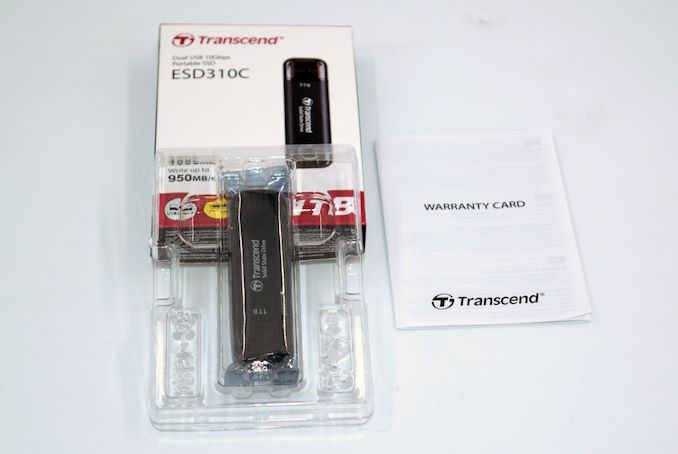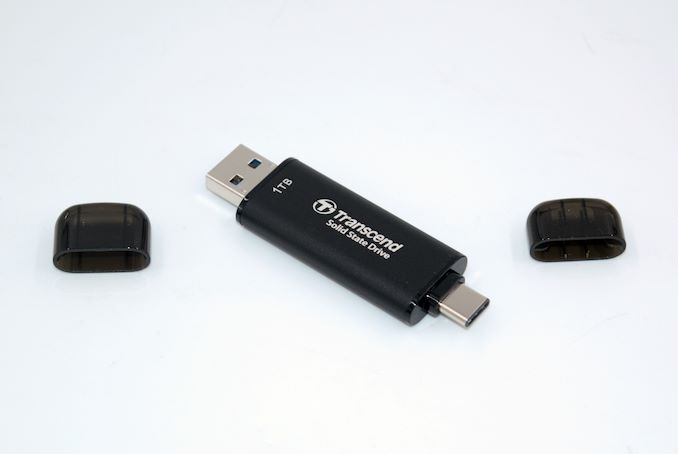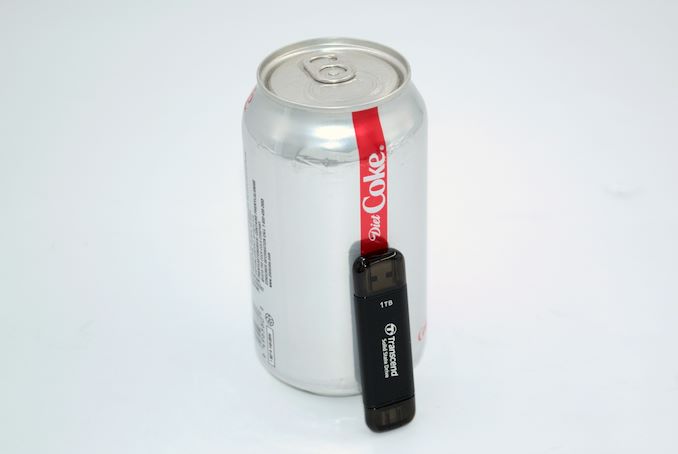
Original Link: https://www.anandtech.com/show/18920/transcend-esd310c-dualinterface-ufd-review-silicon-motion-powers-portable-ssd-in-a-thumb-drive
Transcend ESD310C Dual-Interface UFD Review: Silicon Motion Powers Portable SSD in a Thumb Drive
by Ganesh T S on June 22, 2023 8:00 AM EST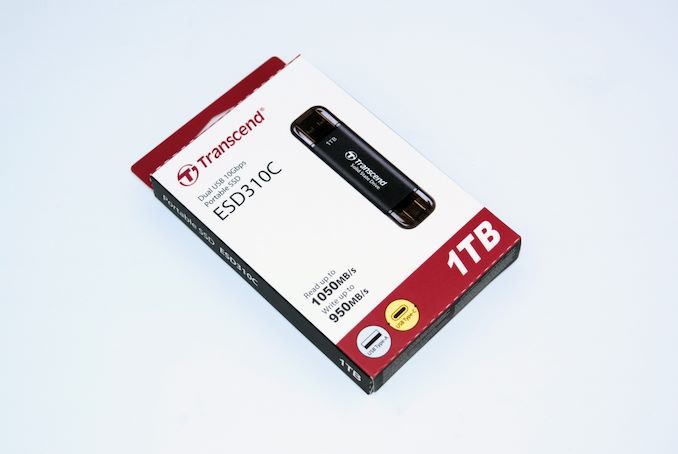
Transcend is a well-known manufacturer of digital storage products, particularly in the industrial space. The company also has plays in the consumer segment, with products ranging from both internal and external SSDs to DRAM modules and card readers.
In April 2023, the company introduced the ESD310C - a portable SSD in a thumb drive form-factor. With claimed read speeds of up to 1050 MBps and write speeds of up to 950 MBps, the USB 3.2 Gen 2 makes its entry into the 10 Gbps-class PSSD market. The main differentiating aspect is the presence of both Type-A and Type-C interfaces. There are four capacity points - 256 GB, 512 GB, 1 TB, and 2 TB.
Kingston's DataTraveler Max had the first mover advantage in the high-performance thumb drive segment. The product line made its debut with a Type-C version, and the Type-A variant was introduced after a few quarters. In the meanwhile, other vendors have tried to differentiate themselves from the Kingston drive by introducing a sturdier version with both Type-A and Type-C interfaces. We took a comprehensive look at one such USB flash drive (UFD) - the OWC Envoy Pro Mini - earlier this year. Transcend's ESD310C attempts to play in the same dual-interface segment, but goes with a traditional thumb drive design and focus on pricing to appeal to a broader consumer base. This review takes a detailed look at the performance and value proposition of the 1 TB version of the new ESD310C, with a particular focus on how it stacks up against the existing players in the segment.
Introduction and Product Impressions
Bus-powered direct-attached storage devices have grown both in storage capacity and speeds over the last decade. The advent of 3D NAND and NVMe, along with faster host interfaces for external devices (such as Thunderbolt and USB 3.2 Gen 2x2), has enabled the introduction of palm-sized flash-based storage devices capable of delivering 2GBps+ speeds.
Prior to the introduction of SATA bridge-based PSSDs, the UFD market was dominated entirely by the thumb drive form factor. Vendors such as Corsair and Mushkin briefly experimented with SATA SSDs behind a USB bridge chip, but the thermal solution and size made the thumb drive UFDs unwieldy. The introduction of high-performance native UFD controllers in recent years from Phison and Silicon Motion has made this category viable again while providing better performance. The Crucial X6, equipped with the Phison U17, was reviewed in August 2021, but it was not a true thumb drive. In that particular category, Silicon Motion has enjoyed significant success, thanks to the popularity of the Kingston DataTraveler Max series (with separate SKUs for Type-C and Type-A drives).
In April 2023, Transcend introduced the ESD310C using essentially the same internals as the Kingston DataTraveler Max Type-A - Silicon Motion's SM2320 native UFD controller coupled with Kioxia's BiCS5 112L 3D TLC NAND. It attempts to differentiate itself from the other high-performance thumb drives based on the following aspects:
- Dual interface support in a single unit (both Type-A and Type-C)
- Reduced width to keep adjacent USB ports free for use
- Highly compact and lightweight
- Caps at either end to protect connectors from dust and accidental damage
Silicon Motion reached out to us for a review of the Transcend ESD310C as yet another vehicle to showcase the versatility of their UFD controller. The company sent across the 1 TB version of the portable SSD to put through our direct-attached storage test suite.
The industrial design of the ESD310C is typical of a thumb drive - a rectangular design with a metal body bookended by plastic tabs sporting the interface connectors. The protection caps are made of plastic. While the metal body provides some rigidity, the plastic caps and the overall lightweight / compact nature lends it a flimsy appearance.
This review will be comparing the ESD310C with a host of other 1 TB PSSDs in both the thumb drive and palm form-factors. CrystalDiskInfo provides a quick overview of the capabilities of the internal storage device. Since the program handles each bridge chip / controller differently, and the SM2320 has not yet found its way into the tracked controllers, many of the entries are marked as vendor-specific, and some of the capabilities (such as the interface) are deciphered incorrectly. However, other S.M.A.R.T features such as temperature read outs worked well.
| Comparative Direct-Attached Storage Devices Configuration | ||
| Aspect | ||
| Downstream Port | Native Flash | 1x PCIe 3.0 x4 (M.2 NVMe) |
| Upstream Port | USB 3.2 Gen 2 Type-A (Male) + Type-C (Male) | USB 3.2 Gen 2 Type-C |
| Bridge Chip | Silicon Motion SM2320 | ASMedia ASM2362 |
| Power | Bus Powered | Bus Powered |
| Use Case | 1GBps-class, compact USB thumb drive with both Type-A and Type-C interfaces | 1GBps-class, IP67-rated rugged and compact portable SSD |
| Physical Dimensions | 71.3 mm x 20 mm x 7.8 mm | 76 mm x 52 mm x 12 mm |
| Weight | 11 grams | 85 grams |
| Cable | N/A | 64.8 cm USB 3.2 Gen 2 Type-C to Type-C Attached Type-C female to Type-A male adapter (resultant Type-C to Type-A cable length : 67.8 cm) |
| S.M.A.R.T Passthrough | Yes | Yes |
| UASP Support | Yes | Yes |
| TRIM Passthrough | Yes | Yes |
| Hardware Encryption | Not Available | N/A |
| Evaluated Storage | Toshiba BiCS5 112L 3D TLC | Kioxia (Toshiba) BiCS 4 96L 3D TLC |
| Price | USD 69 | USD 229 |
| Review Link | Transcend ESD310C 1TB Review | OWC Envoy Pro Elektron 1TB Review |
Prior to looking at the benchmark numbers, power consumption, and thermal solution effectiveness, a description of the testbed setup and evaluation methodology is provided.
Testbed Setup and Evaluation Methodology
Direct-attached storage devices (including thumb drives) are evaluated using the Quartz Canyon NUC (essentially, the Xeon / ECC version of the Ghost Canyon NUC) configured with 2x 16GB DDR4-2667 ECC SODIMMs and a PCIe 3.0 x4 NVMe SSD - the IM2P33E8 1TB from ADATA.
The most attractive aspect of the Quartz Canyon NUC is the presence of two PCIe slots (electrically, x16 and x4) for add-in cards. In the absence of a discrete GPU - for which there is no need in a DAS testbed - both slots are available. In fact, we also added a spare SanDisk Extreme PRO M.2 NVMe SSD to the CPU direct-attached M.2 22110 slot in the baseboard in order to avoid DMI bottlenecks when evaluating Thunderbolt 3 devices. This still allows for two add-in cards operating at x8 (x16 electrical) and x4 (x4 electrical). Since the Quartz Canyon NUC doesn't have a native USB 3.2 Gen 2x2 port, Silverstone's SST-ECU06 add-in card was installed in the x4 slot. All non-Thunderbolt devices are tested using the Type-C port enabled by the SST-ECU06.
The specifications of the testbed are summarized in the table below:
| The 2021 AnandTech DAS Testbed Configuration | |
| System | Intel Quartz Canyon NUC9vXQNX |
| CPU | Intel Xeon E-2286M |
| Memory | ADATA Industrial AD4B3200716G22 32 GB (2x 16GB) DDR4-3200 ECC @ 22-22-22-52 |
| OS Drive | ADATA Industrial IM2P33E8 NVMe 1TB |
| Secondary Drive | SanDisk Extreme PRO M.2 NVMe 3D SSD 1TB |
| Add-on Card | SilverStone Tek SST-ECU06 USB 3.2 Gen 2x2 Type-C Host |
| OS | Windows 10 Enterprise x64 (21H1) |
| Thanks to ADATA, Intel, and SilverStone Tek for the build components | |
The testbed hardware is only one segment of the evaluation. Over the last few years, the typical direct-attached storage workloads for memory cards have also evolved. High bit-rate 4K videos at 60fps have become quite common, and 8K videos are starting to make an appearance. Game install sizes have also grown steadily even in portable game consoles, thanks to high resolution textures and artwork. Keeping these in mind, our evaluation scheme for portable SSDs and UFDs involves multiple workloads which are described in detail in the corresponding sections.
- Synthetic workloads using CrystalDiskMark and ATTO
- Real-world access traces using PCMark 10's storage benchmark
- Custom robocopy workloads reflective of typical DAS usage
- Sequential write stress test
In the next section, we have an overview of the performance of the Transcend ESD310C 1 TB drive in these benchmarks. Prior to providing concluding remarks, we have some observations on the UFD's power consumption numbers and thermal solution also.
Performance Benchmarks
Benchmarks such as ATTO and CrystalDiskMark help provide a quick look at the performance of the direct-attached storage device. The results translate to the instantaneous performance numbers that consumers can expect for specific workloads, but do not account for changes in behavior when the unit is subject to long-term conditioning and/or thermal throttling. Yet another use of these synthetic benchmarks is the ability to gather information regarding support for specific storage device features that affect performance.
Transcend claims read and write speeds of 1050 MBps and 950 MBps respectively. While these numbers are not hit with our ATTO benchmark settings (bypassing the write cache and using a queue depth of 4 for sequential accesses), we find that the writes are faster than a similarly built Kingston DataTraveler MAX A, with read performance being almost the same. In any case, ATTO benchmarking is restricted to a single configuration in terms of queue depth, and is only representative of a small sub-set of real-world workloads. It does allow the visualization of change in transfer rates as the I/O size changes, with optimal performance being reached around 512 KB for a queue depth of 4.
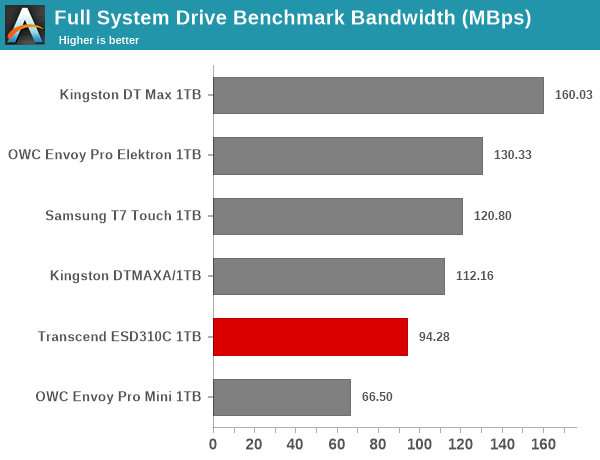
Almost all of the PCMark 10 storage workloads saw the ESD310C emerging as an also-ran when compared with other SM2320-based UFDs. However, it does perform better than the Phison-based UFD, and that is reflected in the overall score. The overall bandwidth and latency are presented in the graphs above.
Miscellaneous Aspects and Concluding Remarks
The performance of the Transcend ESD310C portable SSD in various real-world access traces as well as synthetic workloads was brought out in the preceding sections. We also looked at the performance consistency for these cases. Power users may also be interested in performance consistency under worst-case conditions, as well as drive power consumption. The latter is also important when used with battery powered devices such as notebooks and smartphones. Pricing is also an important aspect. We analyze each of these in detail below.
Worst-Case Performance Consistency
Flash-based storage devices tend to slow down in unpredictable ways when subject to a large number of small-sized random writes. Many benchmarks use that scheme to pre-condition devices prior to the actual testing in order to get a worst-case representative number. Fortunately, such workloads are uncommon for direct-attached storage devices, where workloads are largely sequential in nature. Use of SLC caching as well as firmware caps to prevent overheating may cause drop in write speeds when a flash-based DAS device is subject to sustained sequential writes.
Our Sequential Writes Performance Consistency Test configures the device as a raw physical disk (after deleting configured volumes). A fio workload is set up to write sequential data to the raw drive with a block size of 128K and iodepth of 32 to cover 90% of the drive capacity. The internal temperature is recorded at either end of the workload, while the instantaneous write data rate and cumulative total write data amount are recorded at 1-second intervals.
| CrystalDiskMark Workloads - Power Consumption | |
| TOP: | BOTTOM: |
 |
|
 |
|
The Transcend ESD310C idles at around 0.77W, and has a peak power consumption of 2.28W. The Kingston DTMAX A with similar components (but only a Type-A interface, instead of Type-A + Type-C) idles at approximately the same number and has a peak of 2.31W. However, one important firmware configuration difference appears to be in the entry to a lower power consumption deep-sleep state after a period of inactivity. While the Kingston DTMAX A essentially turns off after 20 minutes or so of inactivity, the ESD310C doesn't. This may be a matter of concern for use with mobile devices, particularly if the user has a tendency to let the UFD remain connected to the USB port after use.
The power consumption numbers are obviously much lower than that of bridge-based solutions like the Samsung T7 Touch and OWC Elektron. The absolute numbers are also lower than the ones for the Phison-based OWC Envoy Pro Mini, and there are no idling period 'garbage-collection spikes' in the power consumption.
Final Words
The Transcend ESD310C was introduced in April 2023 and is slowly making its way to retailers around the world. In the North American market, the SKUs are available on Newegg, with the 1 TB version retailing for $68. The 512 GB and 256 GB versions are available for $49 and $35 respectively. The 2 TB version has been announced, but is not available in retail yet. The main comparison point here in the dual-interface class is the OWC Envoy Pro Mini. The 1 TB version of the OWC UFD retails for $125 - almost double that of the Transcend product. Despite targeting the same dual-interface market, the two products are meant to appeal to different consumer classes. The Transcend ESD310C should satisfy the requirements of most mainstream consumers - folks who don't expect to transfer 100s of GBs in one shot to the UFD. On the other hand, the OWC Envoy Pro Mini does have its own value proposition for prosumers with its unparalleled thermal design and excellent performance consistency under worst-case conditions.
After going through Silicon Motion's pitch for the Transcend ESD310C, I was only mildly interested - as we had already evaluated the performance of the SM2320 UFD in multiple avatars earlier - starting with the controller preview using a Gen 2x2 interface in a bare board and Micron's 96L 3D TLC, and moving on to various Kingston products such as the XS2000 (same NAND and Gen 2x2 interface, albeit with a proper thermal solution and firmware configuration changes), DataTraveler Max (same NAND, but a Gen 2 interface in a thumb drive form factor), and the DataTraveler Max Type-A (Kioxia BiCS5 112L 3D TLC and Gen 2 interface in a thumb drive form factor). Phison's native UFD controllers such as the U17 and U18 have understandable not created as much of an impact as the SM2320 in the PSSD market, but OWC had delivered something compelling using a Phison platform in the Envoy Pro Mini with its dual-interface design. With the Transcend ESD310C, Silicon Motion has shown that its controller can be used in products providing similar connectivity features.
Transcend's industrial design and firmware configuration for the ESD310C has enabled a much lower price point compared to the OWC Envoy Pro Mini. As outlined in different performance sub-sections, the knobs that have been tweaked (such as the SLC cache size, temperature cap for thermal throttling, etc.) make the product suitable for certain use-cases, and a middling performer in others.
Our recommendation for prosumers looking to purchase a dual-interface thumb drive continues to be the OWC Envoy Pro Mini. However, at around half its price and with a more compact design, the Transcend ESD310C makes a compelling case for the mainstream users.

